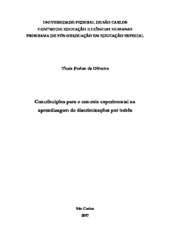Contribuições para o controle experimental na aprendizagem de discriminações por bebês.
Resumo
The literature has emphasized the necessary investigation of the variables acting in
conditional discrimination learning for infants in experimental and natural situations. Part
of the challenge in reaching the research goals with this population lies in the difficulties
of dealing with young children during experimental situations, controlling the presence of
the adult who is the source of social reinforcements and in the necessity of considering the
peculiarities in the population s behavior. The work objective was to identify efficient
experimental variables to teach simple discrimination and identity matching tasks to
infants. Three studies were conducted. In Studies 1 and 2, data was collected from four 12
to 25-month-old participants in an experimental situation organized at their daycare center.
Several toys exerted different stimulus functions and were exposed to the infants in an
apparatus especially designed for this study. The participants worked on simple
discrimination and identity matching tasks, during which the following variables were
manipulated: training procedures; play characteristics with the adult during the moments
of manipulation of toys other than the experimental ones; play characteristics with the
adult while using the toys that had the Sr role. The decisions about the manipulation of
variables were made based on constant analysis of each participant s performance. In the
third study, data was collected from one 17-month-old participant in his own house.
Pictures of animals classified as familiar or unfamiliar to the infant exerted stimulus
function and were presented by the mother in matching auditory-visual tasks, matching
dictated names and figures. The three studies results showed how efficient the
manipulation of variables is to simple and conditional discrimination learning
examination. The variables considered critical were related to designed experimental
conditions, including the training procedures, the stimulus selection, the gauging of
responses and the reinforcement nature. The general discussion emphasized the beneficial
relation between experimental research and natural situation investigations, due to the
possibility of identifying stimulus classes, response classes and appropriate procedures to
teaching simple discrimination and identity matching to infants.
